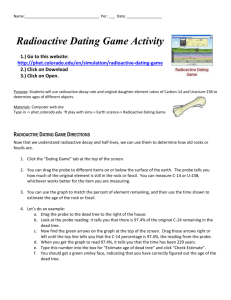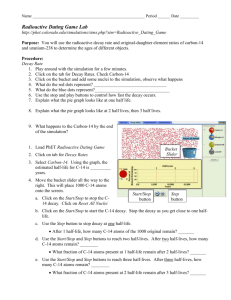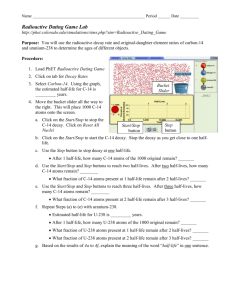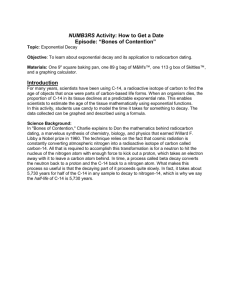Radioactive Dating Game worksheet
advertisement
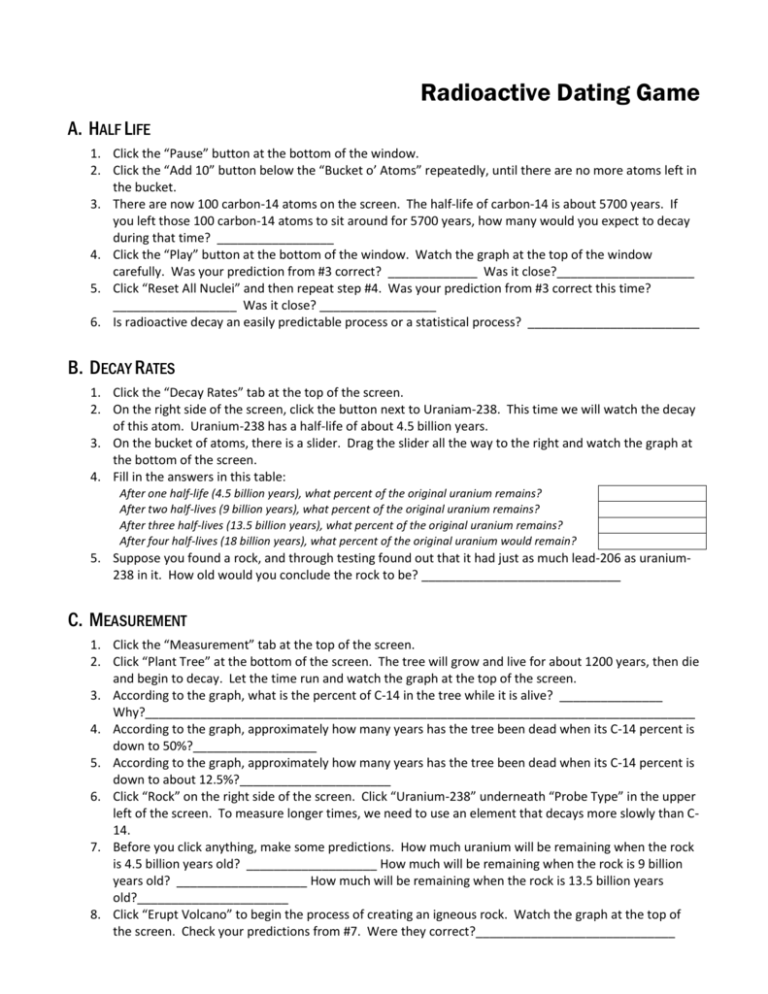
Radioactive Dating Game A. HALF LIFE 1. Click the “Pause” button at the bottom of the window. 2. Click the “Add 10” button below the “Bucket o’ Atoms” repeatedly, until there are no more atoms left in the bucket. 3. There are now 100 carbon-14 atoms on the screen. The half-life of carbon-14 is about 5700 years. If you left those 100 carbon-14 atoms to sit around for 5700 years, how many would you expect to decay during that time? _________________ 4. Click the “Play” button at the bottom of the window. Watch the graph at the top of the window carefully. Was your prediction from #3 correct? _____________ Was it close?____________________ 5. Click “Reset All Nuclei” and then repeat step #4. Was your prediction from #3 correct this time? __________________ Was it close? _________________ 6. Is radioactive decay an easily predictable process or a statistical process? _________________________ B. DECAY RATES 1. Click the “Decay Rates” tab at the top of the screen. 2. On the right side of the screen, click the button next to Uraniam-238. This time we will watch the decay of this atom. Uranium-238 has a half-life of about 4.5 billion years. 3. On the bucket of atoms, there is a slider. Drag the slider all the way to the right and watch the graph at the bottom of the screen. 4. Fill in the answers in this table: After one half-life (4.5 billion years), what percent of the original uranium remains? After two half-lives (9 billion years), what percent of the original uranium remains? After three half-lives (13.5 billion years), what percent of the original uranium remains? After four half-lives (18 billion years), what percent of the original uranium would remain? 5. Suppose you found a rock, and through testing found out that it had just as much lead-206 as uranium238 in it. How old would you conclude the rock to be? _____________________________ C. MEASUREMENT 1. Click the “Measurement” tab at the top of the screen. 2. Click “Plant Tree” at the bottom of the screen. The tree will grow and live for about 1200 years, then die and begin to decay. Let the time run and watch the graph at the top of the screen. 3. According to the graph, what is the percent of C-14 in the tree while it is alive? _______________ Why?________________________________________________________________________________ 4. According to the graph, approximately how many years has the tree been dead when its C-14 percent is down to 50%?__________________ 5. According to the graph, approximately how many years has the tree been dead when its C-14 percent is down to about 12.5%?______________________ 6. Click “Rock” on the right side of the screen. Click “Uranium-238” underneath “Probe Type” in the upper left of the screen. To measure longer times, we need to use an element that decays more slowly than C14. 7. Before you click anything, make some predictions. How much uranium will be remaining when the rock is 4.5 billion years old? ___________________ How much will be remaining when the rock is 9 billion years old? ___________________ How much will be remaining when the rock is 13.5 billion years old?______________________ 8. Click “Erupt Volcano” to begin the process of creating an igneous rock. Watch the graph at the top of the screen. Check your predictions from #7. Were they correct?_____________________________ D. DATING GAME Now that we understand radioactive decay and half-lives, we can use them to determine how old rocks or fossils are. 1. Click the “Dating Game” tab at the top of the screen. 2. You can drag the probe to different items on or below the surface of the earth. The probe tells you how much of the original element is still in the rock or fossil. You can measure C-14 or U-238, whichever works better for the item you are measuring. 3. You can use the graph to match the percent of element remaining, and then use the time shown to estimate the age of the rock or fossil. 4. Let’s do an example: a. Drag the probe to the dead tree to the right of the house. b. Look at the probe reading: it tells you that there is 97.4% of the original C-14 remaining in the dead tree. c. Now find the green arrows on the graph at the top of the screen. Drag those arrows right or left until the top line tells you that the C-14 percentage is 97.4%, the reading from the probe. d. When you get the graph to read 97.4%, it tells you that the time has been 229 years. e. Type this number into the box for “Estimate age of dead tree” and click “Check Estimate”. f. You should get a green smiley face, indicating that you have correctly figured out the age of the dead tree. 5. Repeat the above process for all the other items. Fill in the table below. Item Age Element Used Animal Skull House Living Tree Distant Living Tree Bone Wooden Cup Human Skull Fish Bones Rock 1 Rock 2 Rock 3 Rock 4 Rock 5 Fish Fossil Dinosaur Skull Trilobite Small Human Skull Kevin Fairchild, La Costa Canyon High School, 2011 Hint: For the last four items on the list, neither C-14 or U-238 will work well. Select “Custom”, and pick a half-life that gives you something other than 0.0% on the probe.
